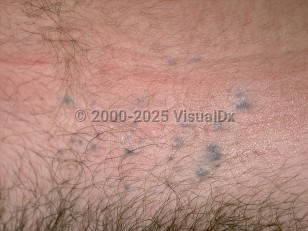Glomangiomas in Adult
See also in: AnogenitalAlerts and Notices
Important News & Links
Synopsis

Glomus tumors are rare benign neoplasms composed of glomus cells, blood vessels, and smooth muscle cells. They are classified according to the dominant cell type into 3 types: glomangioma (60%), solid glomus tumors (25%), and glomangiomyoma (15%). The tumors also exist in 2 forms: solitary and multiple. The most common site for these tumors is on the distal extremities. Multiple glomus tumors are inherited in an autosomal-dominant pattern with incomplete penetrance.
Codes
ICD10CM:
D18.01 – Hemangioma of skin and subcutaneous tissue
SNOMEDCT:
403970001 – Glomangioma of skin
D18.01 – Hemangioma of skin and subcutaneous tissue
SNOMEDCT:
403970001 – Glomangioma of skin
Look For
Subscription Required
Diagnostic Pearls
Subscription Required
Differential Diagnosis & Pitfalls

To perform a comparison, select diagnoses from the classic differential
Subscription Required
Best Tests
Subscription Required
Management Pearls
Subscription Required
Therapy
Subscription Required
References
Subscription Required
Last Updated:11/11/2021
Glomangiomas in Adult
See also in: Anogenital
